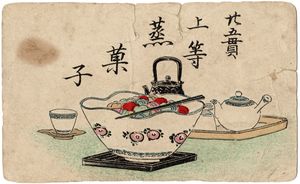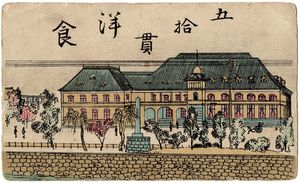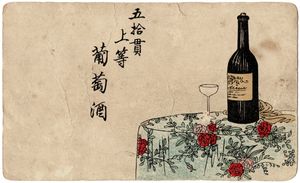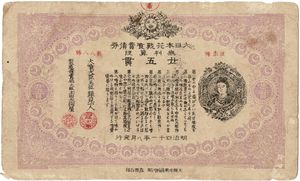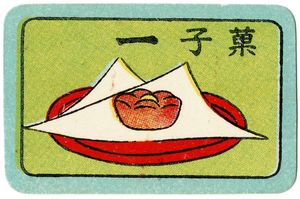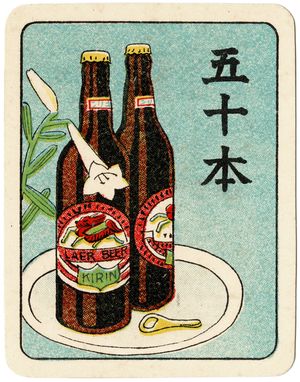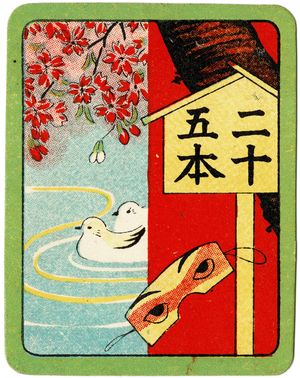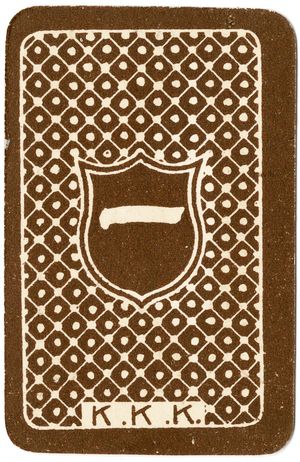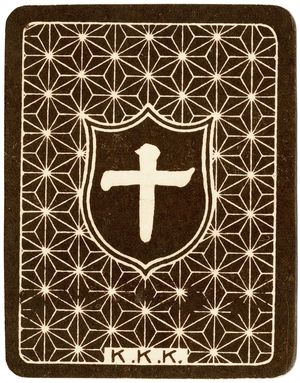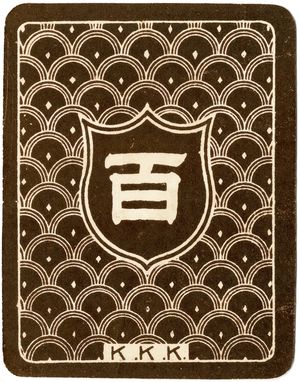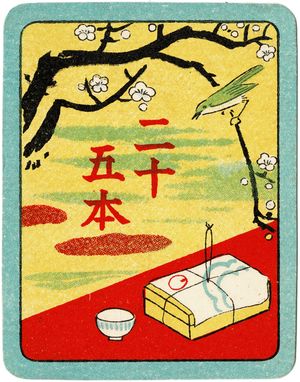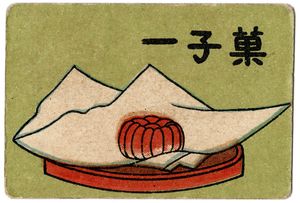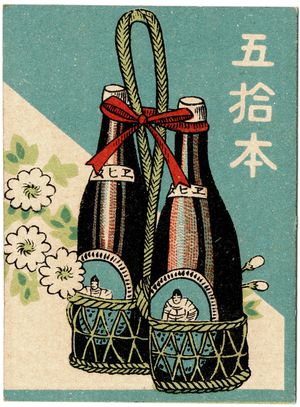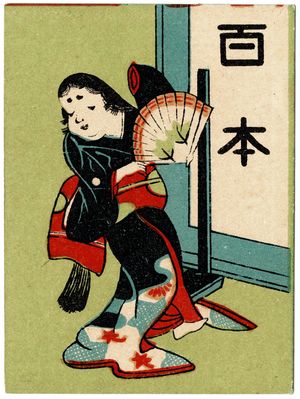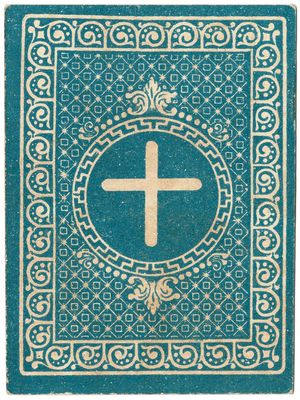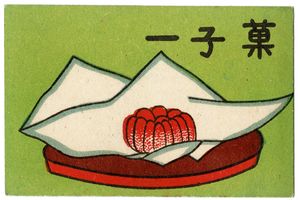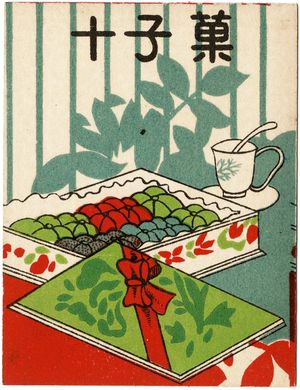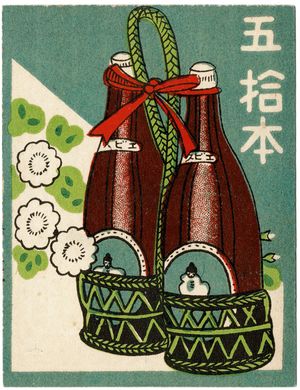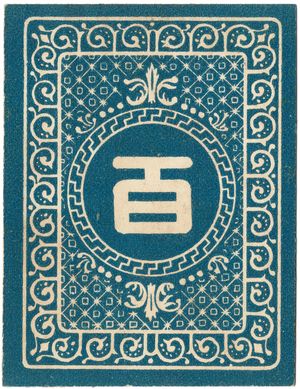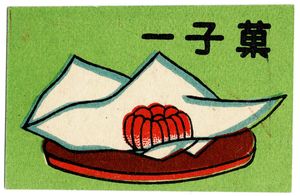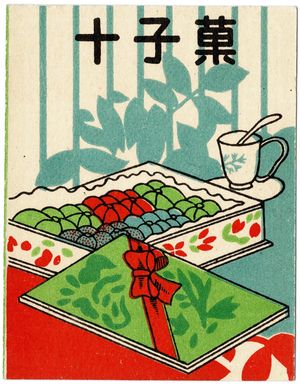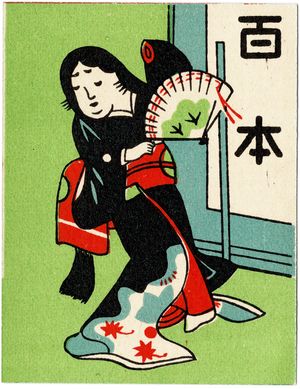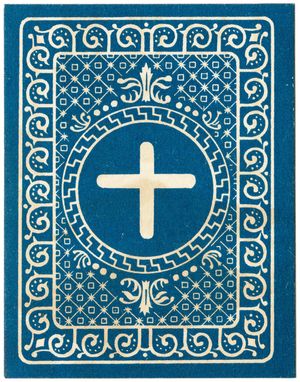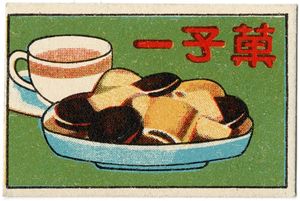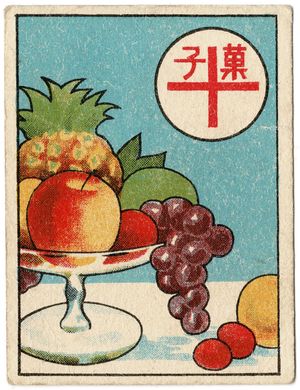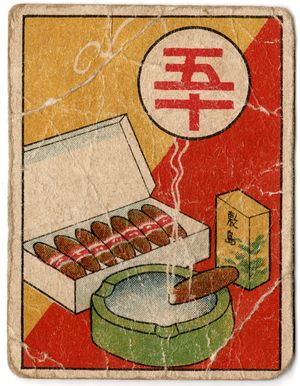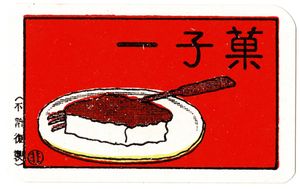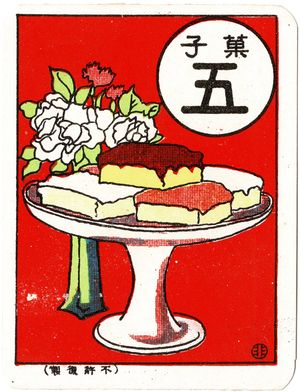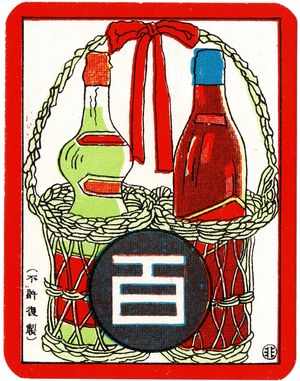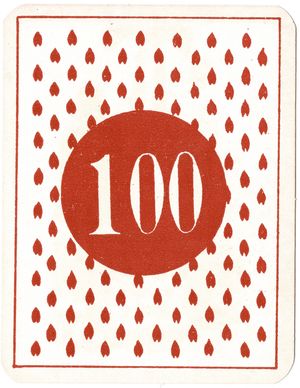Hachi-Hachi
八八
Draft
◦ last updated:
Hachi-Hachi (八八, ‘88’) is the preëminent Hanafuda gambling game for 3–7 players. In many old English sources it is considered synonymous with ‘hanafuda’ or ‘hana-awase’ and isn’t given a more specific name.
Ref: A[p. 39] Gimmi 88: The Popular Japanese Card Game Hachi Hachi (Eighty-Eight): Japanese Card Game 花かるたの遊び [Playing Hana-Karuta]
The name derives from the objective of the game; the standard version of the game is for three active players, and there are 264 total card points available, so the goal for each player is to obtain at least their share, i.e. 264 ÷ 3 = 88 points.
Despite being — historically, at least — the most important Hanafuda game, it is also one of the most difficult. The play of the cards is the same as in other Hanafuda games, but the procedures of betting and payment combine to increase the complexity. There are also multiple sets of yaku, and specialized equipment that was commonly used with the game.
Rules
Yaku • 役
The Hachi-Hachi yaku are divided into two categories: teyaku (手役 ‘hand combinations’), which are combinations that are found in the dealt hands, and dekiyaku (出役 ‘coming-out combinations’), which are combinations that are captured during play.
Teyaku • 手役
The teyaku can be divided into two sets. The first set is based upon having sets of cards in the same month, and the second set is based upon having a large number of 1-point (kasu) cards. A player can score one combination in each set; they should pick the highest-scoring combination.
Note that in many ways the teyaku combinations should be considered compensation for having a hand that is hard to win with, rather than a straightforward “winning combination” as in Texas Hold’em. As an example, a hand that has two pairs of three can only capture a maximum of three cards that are not already contained in the hand.
Combinations based upon sets:
- sanbon • 三本 (さんぼん) • three-of-a-kind/3
- Three cards of the same month.
- tatesanbon • 立三本 (たてさんぼん) • special three-of-a-kind/3*
- Three cards of the months of Wisteria, Iris, Bush Clover, or the three kasu of Paulownia. This is worth more because these months cannot contribute towards the aka-tan or ao-tan dekiyaku, so this form has a higher compensation.Also written as 竪三本 or たて三本.
- futa-sanbon • 二三本 (ふたさんぼん) • two three-of-a-kind/3–3
- Two sets of three cards of the same month.Also written as 二三本, 二タ三本, ふた三本, 双三本.
- kuttsuki • 喰付 (くっつき) • three pairs/2–2–2
- Three pairs from three different months.Also written as 食付, クツッキ, 三双, 相合.
- teshi • 手四 (てし) • four-of-a-kind/4
- All four cards of a single month.
- haneken • はねけん • 2–2–3
- Three cards of one month, and two pairs from two different months.Also written as はねけん三, 二二三, けんぎん, 八子ケン, 跳劒, 羽見(ン)三, ハネケン.
- ichi-ni-shi • 一二四 • 1–2–4
- Four cards of one month, and a pair from another month, along with any other card.Also written 一弐四, 一にし.
- shi-sō • 四三 (しそう) • 4–3
- All four cards of the same month, and three cards of another month.Also written 𛁈さう.
Combinations based upon kasu cards. Remember that all Willow (November) cards count as kasu in this game:
- aka • 赤 (あか) • ‘red’
- At least two ribbon cards (despite the name, the colour does not matter), and the rest kasu. Note that this should not be confused with the aka-tan dekiyaku.Also written アカ.
- tan-ichi • 短一 • one ribbon
- Only one ribbon card, and the rest kasu.Also written 丹一, タン一, 丹・1.
- tō-ichi • 十一 • one ten
- Only one ten-point card, and the rest kasu.Have seen this written as 10・一.
- pika-ichi • 光一 • one bright
- Only one bright card, and the rest kasu.Also written ひかり一, ガチャ, がちや, ピカ・1.
- karasu • カラス (からす) • all kasu
- A hand consisting of only kasu cards.Also written 空巣, 空素, 空巢.
Thus, the highest-scoring hand possible has both shisō and karasu; there is only one way this hand can be formed, giving it a 1-in-73 629 072 chance of occurring! Even ordinary shisō has a mere 1-in-139 449 chance of being dealt, and when this happens it is a common house rule that the round is instantly won by the player who receives such a hand; some sources suggest that the deck should then be burned.
The exceedingly rare highest-possible dealt hand.
© 2021 Louie Mantia 🅭🅯🄎
The overall number of possible hands with combinations from each set of teyaku are as follows. Each cell indicates the number of possible hands which contain both the given ‘set’ and ‘kasu’ yaku, as well as the overall probability (many entries round to zero). By inverting the probability of the top-left entry, we can see that a teyaku is expected in about 1-in-4 dealt hands.
| No kasu yaku | Aka ribbons & kasu |
Tan-ichi ribbon & kasu |
Tō-ichi 10-pt & kasu |
Pika-ichi Bright & kasu |
Karasu all kasu |
Total | |
|---|---|---|---|---|---|---|---|
| No set yaku | 54 461 388 (73.97%) |
4 384 404 (5.95%) |
2 414 232 (3.28%) |
2 145 984 (2.91%) |
1 053 432 (1.43%) |
826 704 (1.12%) |
65 286 144 (88.67%) |
| Sanbon 3 |
4 025 772 (5.47%) |
209 436 (0.28%) |
136 548 (0.19%) |
117 240 (0.16%) |
95 964 (0.13%) |
35 040 (0.05%) |
4 620 000 (6.27%) |
| Tatesanbon 3* |
1 497 072 (2.03%) |
94 680 (0.13%) |
54 936 (0.07%) |
52 968 (0.07%) |
5 904 (0.01%) |
10 440 (0.01%) |
1 716 000 (2.33%) |
| Futasanbon 3–3 |
38 280 (0.05%) |
1 440 (0.00%) |
990 (0.00%) |
880 (0.00%) |
570 (0.00%) |
80 (0.00%) |
42 240 (0.06%) |
| Kuttsuki 2–2–2 |
1 473 048 (2.00%) |
100 512 (0.14%) |
52 758 (0.07%) |
46 896 (0.06%) |
23 916 (0.03%) |
13 590 (0.02%) |
1 710 720 (2.32%) |
| Teshi 4 |
118 632 (0.16%) |
768 (0.00%) |
1 782 (0.00%) |
1 584 (0.00%) |
2 454 (0.00%) |
1 500 (0.00%) |
126 720 (0.17%) |
| Haneken 2-2–3 |
84 804 (0.12%) |
4 176 (0.01%) |
2 349 (0.00%) |
2 088 (0.00%) |
1 218 (0.00%) |
405 (0.00%) |
95 040 (0.13%) |
| Ichi-ni-shi 1–2–4 |
29 776 (0.04%) |
144 (0.00%) |
486 (0.00%) |
432 (0.00%) |
572 (0.00%) |
270 (0.00%) |
31 680 (0.04%) |
| Shisō 4–3 |
500 (0.00%) |
0 (impossible) |
9 (0.00%) |
8 (0.00%) |
10 (0.00%) |
1 (0.00%) |
528 (0.00%) |
| Total | 61 729 272 (83.84%) |
4 795 560 (6.51%) |
2 664 090 (3.62%) |
2 368 080 (3.22%) |
1 184 040 (1.61%) |
888 030 (1.21%) |
73 629 072 |
Dekiyaku • 出役
The number of dekiyaku is much smaller than the number of teyaku, but the number of them has grown over the time the game has been played.
The basic set of dekiyaku is:
- aka-tan • 赤短 (あかたん) • red ribbons
- All three red tanzaku with writing.
- ao-tan • 青短 (あおたん) • blue ribbons
- All three blue tanzaku (all of which have writing).
- shi-kō • 四光 (しこう) • four brights
- The four Bright cards (excluding the rain man).
- go-kō • 五光 (ごこう) • five brights
- All five Bright cards.
The Yaku in Depth
Aka-tan • 赤短 • “red ribbons”
This yaku is made up of exactly the three red tanzaku cards of the first three months (pine, plum, cherry). No other tanzaku may be used to complete it.
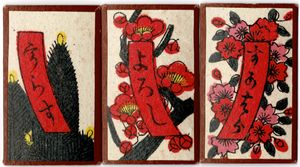
The cards that form the Aka-tan/Ura-Sugawara yaku, from an old Tanaka Gyokusuidō deck. The cards are labelled 𛀋らす (urasu), よろし (yoroshi), and す𛀙𛂦ら (sugawara).
© George Pollard 🅭🅯🄏🄎
It was also formerly known as ura-sugawara (裏菅原, ‘behind/inside Sugawara’) or urasu for short.Other spellings of urasu (うらす) include 裏, 裏す, 宇良す, or 𛀋らす. This name was a reference to the popular kabuki play Sugawara Denju Tenarai Kagami (菅原伝授手習鑑, ‘Sugawara and the Secrets of Calligraphy’). In the play the three main characters are brothers who are named after the three plants featured on the cards: Matsuōmaru (松王丸, pine), Umeōmaru (梅王丸, plum), and Sakuramaru (桜丸, cherry). In the play the brothers wear costumes which bear symbols of the plants related to their names.
The yaku can also be called yoroshī (よろしい, ‘good’) or akayoro (赤よろ, ‘red good’), or even simply aka (緋, ‘scarlet’), although this risks confusion with the aka teyaku.
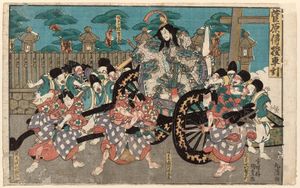
The ‘Kurumahiki’ (車引き, carriage-pulling) scene from Sugawara and the Secrets of Calligraphy.
The three brothers can be seen at front wearing clothes bearing the plants: cherry blossoms, plum blossoms, and pine trees.
An 1841 print by Utagawa Kunisada (歌川国貞).
Equipment
Kashifuda • 菓子札 • “sweets cards”
Kashifuda are cards that are used to stand in for money, since playing gambling games for real money has almost always been illegal in Japan. The name means ‘sweets cards’, but is also a pun on 貸し kashi (‘debt/favour’), so can be understood as ‘debt cards’. I think the name was originally probably meant to be the latter but was later modified into the current form. In any case, the cards usually show pictures of food and drink.
It is unclear how literally the images should be taken — did a card depicting a steak dinner require the loser to make payment in kind? It is fun to imagine so, but I have no evidence to support this.
Old-style Kashifuda (c. 1920?), published by Tsuchida Tenguya. At top left, two 25-kan notes, the left one reading 小鯛雀𛁋し (‘Kodai Suzume sushi’), a sushi restaurant that opened in Ōsaka in 1781, and apparently a favourite of Emperor Meiji; the other reads 上等蒸菓子 (‘fine steamed confectionary’). The two 50-kan cards (top right, bottom left) are for 洋食 (‘Western meal’) and 上等葡萄酒 (‘fine wine’). The reverse of the cards is designed to look like a Meiji-era 1-yen banknote that bore a portrait of the Empress Jingū, and which was used from 1881 until 1899. The set also contained (not pictured here) another 50-kan card and a 100-kan card.
© George Pollard 🅭🅯🄏🄎
Kashifuda as published by Kamigataya in denominations of 1, 10, 50, 100, and two different 25 cards (the only two in the set). The reverse bears the name “K.K.K.” which stands for Kamigataya Kabushiki Kaisha.
© George Pollard 🅭🅯🄏🄎
Nintendo-style Kashifuda cards, in denominations of 1, 10, 50, and 100.
© George Pollard 🅭🅯🄏🄎
Later (redrawn) Nintendo-style Kashifuda cards, in denominations of 1, 10, 50, and 100.
© George Pollard 🅭🅯🄏🄎
Yet later (slightly redrawn) Nintendo-style Kashifuda cards, in denominations of 1, 10, 50, and 100.
© George Pollard 🅭🅯🄏🄎
Kashifuda cards produced by Nakao Seikadō, in denominations of 1, 10, 50, and 100, and the reverse of the 10. It is unclear what “NNN” means, but it may be in imitation of the “KKK” used by Kamigataya.
© George Pollard 🅭🅯🄏🄎
Kashifuda by an unknown manufacturer, in denominations of 1, 5, 25, and 100.
© George Pollard 🅭🅯🄏🄎
Notes:
A set in the Pitts River museum: https://www.prm.ox.ac.uk/collections-online#/item/prm-object-96895
References
Japan Publications, Inc. (publisher) (, originally published 1970). Hanafuda: The Flower Card Game (15th edition). Japan Publications, Inc.: Sarugaku-cho, Chiyoda-ku, Tokyo, Japan. ISBN: 978-0-87040-430-6.
Yoshino, N. (). Gimmi 88: The Popular Japanese Card Game. The Katagiri Brothers.
“Stray Sheep” [Tatsuo Suzuki] (). Hachi Hachi (Eighty-Eight): Japanese Card Game. Kōtsu Nippon Sha: Nihombashi, Tokyo.
片岡, 百合雄 [Kataoka Yurio] (). 花かるたの遊び [Playing Hana-Karuta]. Kamigataya K.K.








